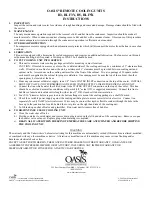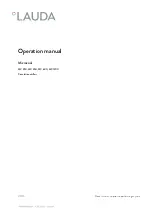
Operation
29
Control parameters
The control parameters for cooling the device are set to a thermal fluid with water when
the device is delivered. Depending on the application and the thermal fluid used, it may
become necessary to adjust the control parameters.
The quality of the control system deteriorates at increasingly lower temperatures due to
the change in viscosity of the thermal fluid at low temperatures. This means that if you
work with a normal cooling temperature of -20 °C, for example, the control parameters
should be adjusted at an operating temperature of -10 °C.
Please keep this in mind when setting the control parameters.
Internal control parameters
The internal control parameters compare the internal setpoint temperature with the flow
line temperature. This calculation results in the control variable used for cooling.
Parameter Designation
Explanation
Unit
Xp
Proportional range
Specifies the temperature range in which
the proportional component (P compo
-
nent) of the controller is 0 ... 100 % of the
maximum control variable.
For example, if the control deviation is 2 K
with an Xp of 10 K set, the P component
is 20 % of the control value. For a control
deviation of 10 K and more, the P compo
-
nent is 100 % of the control variable.
K
Tn
Reset time
Is decisive for the integral component
(I component) of the control variable.
It specifies the interval during which an
existing control deviation is integrated.
The larger Tn is, the slower the control
deviation is integrated. This makes the
control slower. A smaller Tn makes the
control more dynamic and finally leads to
oscillations
.
s
Tv
Rate time
This forms the differential component (D
component) of the control variable. It
influences the approach speed of the actual
value to the setpoint and counteracts the P
and I components.
The higher the setting for the rate time Tv,
the stronger the output signal is damp
-
ened. The rule of thumb is:
Tv = Tn x 0,75.
s.
Summary of Contents for Hei-CHILL 3000
Page 118: ...Service 118...
Page 119: ......
















































